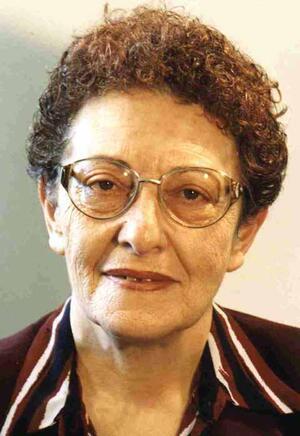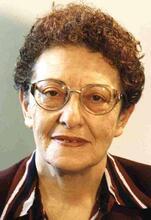Chava Turniansky
Chava Turniansky is a leading scholar of Old Yiddish. Born in Mexico, Turniansky attended the Yidishe Shul, took private Hebrew lessons, and joined the Socialist Zionist Youth Movement. In 1957 she emigrated to Israel, where she first studied education and went on to study Yiddish with some of the most prominent scholars of the time. Her publications shed light on the manifold aspects of Ashkenazi life, literature, and culture, including its internal bilingualism, the way literacy and knowledge are transmitted, how men and women are educated, book production and reception, and women readers and writers. Turniansky views not just as the vernacular of fourteenth to eighteenth century Jewish society but as a vehicle for understanding the literary, philological, historical and sociological mores of the period.
Background and Early Education
Chava (née Punsky) Turniansky was born on July 21, 1937, in Mexico D.F., Mexico. Her father, Avrom Punsky (1906–1977), born in Visoki Dvor (today Aukstadvaris), Lithuania, where he received a traditional Jewish education (Lit. "room." Old-style Jewish elementary school.heder and yeshivah), emigrated to Mexico in 1924 and earned his living as a merchant. In 1936 he married Bela Pomerancenbaum (1905–1975), who was born in Grajewo, Poland, where she attended elementary and middle school and earned a living as a seamstress before emigrating to Mexico in 1935. The Punskys also had a son, Moshe (b. 1942).
Chava attended kindergarten and primary and secondary school at the Yidishe Shul in Meksike (Colegio Israelita de Mexico), took additional private Hebrew lessons, and in 1947 joined the Ha-Shomer ha-Za’ir, a Socialist Zionist youth movement. After graduating she was sent by the Yidishe Shul to attend a one-year program of studies (1955) at the Bet-Hamidrash le-Morey ha-Gola al-shem Hayyim Grinberg, the Seminar for Teachers in the Diaspora, in Jerusalem. She returned to Mexico to teach Hebrew and Yiddish at her school for two years (1956–1958), while also studying pedagogy at the Faculty of Humanities of the Universidad Nacional Autónoma de México. In 1957 she emigrated to Israel and worked in the Yiddish section of Kol Israel, the Israeli public radio station. In 1958 she married Uriel Turniansky (1930–1989), an economist and statistician, with whom she had three sons: Elisha (1960), Avner (1964), and Meir (1969).
Professional Career
Following a year of studies at the Department of Elementary Education of the Hebrew University and a second year at the David Yellin Teachers’ Seminary, she received her teaching diploma in 1960 and began her B.A. studies in Yiddish literature and Jewish history at the Hebrew University. After graduating in 1963 she started teaching Yiddish at the university and obtained her M.A. degree in 1967. Among her university teachers were some of the most prominent scholars of the time: Israel Halpern, Haim Hillel Ben-Sasson and Shmuel Etinger in Jewish History and Dov Sadan, Chone Shmeruk, and Shmuel Werses in Yiddish and Hebrew literature. Her Ph.D. thesis, on bilingual (Hebrew and Yiddish) literature in Ashkenaz (the Rhineland section of Germany and neighboring France) in the early modern period, was written under the supervision of Shmeruk and approved in 1974. Since 1963 she has been a member of the faculty at the Hebrew University and has for long periods served as head of the Department of Yiddish.
Her first published work—“The Metamorphoses of Peretz’s ‘Monish,” published in Die goldene keyt in 1965, is a detailed comparative study of four versions of the author’s first literary work in Yiddish It demonstrates the gradual change of attitude towards Yiddish of one of the classical writers of modern Yiddish literature, from clear disapproval to its adoption as a main language of writing. Turniansky’s primary research interests are centered on Old Yiddish literature (fourteenth–eighteenth centuries), a field in which she is a leading scholar. Her research is syncretic; she considers the literary, philological, historical, sociological aspects of the text in her analysis of Old Yiddish works—manuscripts and printed books. She also studies the text’s sources, functions, and implications and places it in the framework of Jewish bilingual (Hebrew and Yiddish) life and society as well as its contacts with the surrounding cultures (German, Italian, Slavic).
Turniansky’s publications shed light on the manifold aspects of Jews of European origin and their descendants, including most of North and South American Jewry.Ashkenazi life, literature and culture, including its internal bilingualism, the way literacy and knowledge are transmitted, how males and females are educated, book production and book reception, to whom Old Yiddish Literature is addressed, and women readers and writers. She pays special attention to the function of Yiddish as a vehicle for Hebrew sources, mainly the Bible: translations and adaptations, derashot (oral and written sermons), teaching in the heder, epic poems, and the Ze’enah u-Re’enah, a Yiddish language prose work sometimes known as the women’s Bible.
Turniansky has studied the appearance of old Yiddish in many genres, for instance in bilingual (Yiddish and Hebrew) songs and poems and in “historical” songs that deal with actual events. Traces of old Yiddish language and literature, she notes, also appear in the works of modern writers such as Abraham Sutzkever and Isaac Bashevis Singer. Her critical edition of Glikl of Hameln’s book of memoirs - the original Yiddish text and Turniansky’s new Hebrew translation, published in 2006 under the title Glikl Zichronot- sheds light not only on the life of one exceptional Jewish woman in central Europe, but on the world of Jewish women and a whole Jewish society in the early modern period.
Turniansky is an internationally known scholar and has lectured in many institutions, for instance at the Oxford Center for Postgraduate Hebrew studies (1975); the Universidad Iberamericana de Mexico (1984); the Institute of Hebrew and Jewish Studies, University College London (1988), Instito de Glottologia e lingue orientai of the Universita degli studi di Milano (three yearly courses) 1991-1993; and at the University of California at Berkeley (2002).
For her outstanding research work Turniansky has been awarded several prizes: Eliezer Pines Foundation (1978); Emma Schaver Prize (1987); Shalom Alaichem prize (1987); Itzik Manger Prize (1988); Bialik Prize (2006); and the most prestigious prize in Israel, the Israel Prize for research of the Jewish Languages and their Literature (2013). In 2007 Turniansky was elected to the Israel National Academy of Science.
Turniansky retired from the Hebrew University in.2006 but continues her research, teaching, lecturing, and writing.
Selected Works by Chava Turniansky
Books
Fun Undzer Yiddisher Yiddisher Literature, layen buch farn limud fun Yiddish, collected and edited by Chava Turniansky. Tel Aviv; 1980, 1983.
Alexander ben Yizhak Pfaffenhofen: Sefer Massah U-Merivah, 1627. Edited from the Original Manuscript with Introduction and Annotations (Hebrew and Old Yiddish). Jerusalem: Magnes, 1985.
The Jews of Eastern Europe: History and Culture (Hebrew). Tel Aviv: The Open University of Israel, 1994.
“Special Traits of Yiddish Literature in Italy.” In Yiddish in Italia: Manuscripts and Printed Books (Italian), edited by Chava Turniansky and Erika Timm. Milan: Associazione Italiana Amici di Gerusalemma, 2003.
Glikl, Memoires 1691–1719, edited and translated from the Yiddish by Chava Turniansky (Yiddish and Hebrew). Shazar: Jerusalem: 2006,
Glikl: Memoirs 1691-1719, (English) presented by Chava Turniansky. Waltham, MA: Brandeis University Press, 2019.
Yiddish Letters: From the Seventeenth-Century World of Glikl Hamel (English and Yiddish) Arthur Arnheim and Chava Turniansky. Jerusalem: Magnes, 2019.
Articles
“The Metamorphoses of Peretz’s Poem Monish.” Di goldene keyt 52 (1965): 205–244. (Yiddish).
“The ‘bentsherl’ and the ‘zemiroth’ in Yiddish.” Alei Sefer 10 (1982): 51–92.(Hebrew).
“Sutzkever and Old-Yiddish.” In Yikhes fun lid / yikhuso shel shir - For Abraham
Sutzkever on His Seventieth Birthday, edited by D. Sadan, Y. Avrech, Ch. Turniansky, Ch. Shmeruk, 62-88. Tel-Aviv: 1983. (Yiddish).
“To the History of the ‘taytsh-khumesh’ - ‘khumesh mit khiber.’” In Devarim sheneemru beerev likhvod Dov Sadan bimlot lo shmonim vehamesh shana, 21-58. Jerusalem: The Israel Academy of Sciences and Humanities, 1988. (Hebrew).
“Yiddish Song as Historical Source Material: Plague in the Judenstadt of Prague in 1713." Jewish History: Essays in Honour of Chimen Abramsky, edited by Ada Rapoport-Albert, and Steven J. Zipperstein, 189-198. London: P. Halban, 1988.
“The Events in Frankfurt am Main (1612–1616) in Megillas Vints and in an Unknown Yiddish 'Historical' Song.” In Schöpferische Momente des europäischen Judentums, edited by Michael Graetz, 121-137. Heidelberg: Universitatverlag C. Winter, 2000.
“The Sources of Isaac Bashevis-Zinger’s Der sotn in Goray.” In Isaac Bashevis Singer: His Work and His World, edited by Hugh Denman, 243-264. Leiden-Boston: Brill, 2002.
“’His eyes are like stars, like gold is his hair’: Yosef hatsadik in an Old Yiddish Poem.” Tar.biz 76 (2007): 471–500 (Hebrew)
“The Maskilic Versions of Tsene-Rene.” In Let the Old Make Way for the New: Studies in the Social and Cultural History of Eastern European Jewry Presented to Immanuel Etkes, edited by David Assaf and Ada Rapoport-Albert, 313-344. Jerusalem: The Zalman Shazar Center for Jewish History, 2009 (Hebrew).
“Heder Education in the Early Modern Period.” The Heder. Studies, Documents, Literature and Memoirs, edited by D. Assaf and I. Etkes, 3-36. Tel Aviv: Tel Aviv University Press, 2010 (Hebrew).
“From the Encounter of Hebrew and Yiddish: Two Languages. One Society.” Milestones: Essays in Jewish History Dedicated to Zvi (Kuty) Yekutiel, edited by. I. Etkes, D. Assaf, Y. Kaplan, 261-275. Jerusalem: The Zalman Shazar Center for Jewish History, 2015 (Hebrew).
“Hayo hayu kruzim: hatsatsah be-pinkas kruzim yashan.” In Rafael Weiser Memorial Volume, Studies in Manuscripts, Archives and Agnon's Writing, edited by Gil Waissblei, 101-115. Mineged Hotsa'ah La'or: 2020 (Hebrew).
“’The Reading Repertoire' of Early Modern Ashkenazi Women.” In Reflections on Booklore: Studies Presented to Prof. Avidov Lipsker, edited by Y. Schwartz, L. Nethanel, C. Rosenzweig, R. Tausinger 185-204. Ramat Gan: Bar-Ilan University Press 2020 (Hebrew).




